Note: There is now a newer Novel Coronavirus (2019-nCoV) Situation Report 20.
WHO Novel Coronavirus (2019-nCoV) Situation Report 19
- No new countries reported cases of 2019-nCoV in the past 24 hours.
- The infection prevention and control (IPC) global network is convened through weekly teleconferences with international IPC experts to discuss technical aspects of IPC measures, share epidemiological updates and experiences regarding the IPC measures put in place in affected countries. In consultation with the global IPC expert network, WHO has released three key IPC interim guidance materials on IPC measures during health care and home care, as well as advice on the use of masks in various settings.
Risk Assessment
China: Very High
Regional Level: High
Global Level: High
Coronavirus Situation in Numbers
Globally
- 34886 confirmed (3419 new)
China
- 34598 confirmed (3401 new)
- 6101 severe (1280 new)
- 723 deaths (86 new)
Outside of China
- 288 confirmed (18 new)
- 24 countries (0 new)
- 1 death (0 new)
Technical Focus: Infection prevention and control
From the beginning of this outbreak, WHO has convened several global expert networks for laboratory, clinical management, mathematical modeling, risk communication and community engagement, and infection prevention and control (IPC). The IPC global network is convened through weekly teleconferences with international IPC experts to discuss technical aspects of IPC measures, share epidemiological updates and experiences regarding the IPC measures put in place in affected countries. International participants are members of the Global Infection Prevention and Control Network (GIPCN) or members of relevant institutions caring for infected 2019-nCoV acute respiratory disease patients.
In consultation with the global IPC expert network, WHO has released three key IPC interim guidance materials. These materials are available here: https://www.who.int/emergencies/diseases/novel-coronavirus-2019/technical-guidance
The first document — Infection prevention and control during health care when novel coronavirus (2019-nCoV) infection is suspected. Interim guidance v2 — defines the following five IPC strategies to prevent or limit human to human transmission in health care settings:
- Ensuring triage, early recognition, and source control (isolating patients with suspected 2019-nCoV infection);
- Applying standard precautions for all patients;
- Implementing empiric additional precautions (droplet and contact and, whenever applicable, airborne precautions) for suspected cases of 2019-nCoV infection;
- Implementing administrative controls;
- Using environmental and engineering controls.
The second document — Home care for patients with suspected novel coronavirus (2019-nCoV) infection presenting with mild symptoms and management of contacts. Guidance – v2 – provides recommendations in the context of home care for mild patients. Guidance is provided (i) for a household/caregiver’s protection including which personal protective equipment (PPE) to wear when caring for someone infected with 2019-nCoV and on environmental and waste management; (ii) for an infected individual with mild disease, for example to wear a mask; and (iii) for the management of contacts (including caregivers/health care workers) which includes 14 days of monitoring of health for contacts.
The third document — Advice on the use of masks in the community, during home care and in health care settings in the context of the novel coronavirus (2019-nCoV) outbreak. Interim guidance – v1. In community settings, medical masks are not recommended for people without symptoms. For those who choose to wear medical masks, appropriate mask management should be followed, which includes how to use and dispose of masks. Symptomatic individuals are recommended to wear medical masks and seek early medical care if there are any signs of respiratory distress.
Countries, territories or areas with reported confirmed cases of 2019-nCoV, February 8, 2020
| Country/Territory/Area | Confirmed Cases |
|---|---|
| China | 34598 |
| International (Cruise Ship in Japan) | 64 |
| Singapore | 33 |
| Thailand | 32 |
| Japan | 25 |
| Republic of Korea | 24 |
| Australia | 15 |
| Malaysia | 15 |
| Germany | 14 |
| Vietnam | 13 |
| United States of America | 12 |
| Canada | 7 |
| United Arab Emirates | 7 |
| France | 6 |
| India | 3 |
| Italy | 3 |
| Philippines | 3 |
| United Kingdom | 3 |
| Russian Federation | 2 |
| Belgium | 1 |
| Cambodia | 1 |
| Finland | 1 |
| Nepal | 1 |
| Spain | 1 |
| Sri Lanka | 1 |
| Sweden | 1 |
| Total | 34886 |
Recommendations and Advice for the Public
During previous outbreaks due to other coronaviruses (Middle-East Respiratory Syndrome (MERS) and Severe Acute Respiratory Syndrome (SARS), human-to-human transmission occurred through droplets, contact, and fomites, suggesting that the transmission mode of the 2019-nCoV can be similar. The basic principles to reduce the general risk of transmission of acute respiratory infections include the following:
- Avoiding close contact with people suffering from acute respiratory infections.
- Frequent hand-washing, especially after direct contact with ill people or their environment.
- Avoiding unprotected contact with farm or wild animals.
- People with symptoms of acute respiratory infection should practice cough etiquette (maintain distance, cover coughs and sneezes with disposable tissues or clothing, and wash hands).
- Within healthcare facilities, enhance standard infection prevention and control practices in hospitals, especially in emergency departments.
WHO does not recommend any specific health measures for travelers. In case of symptoms suggestive of respiratory illness either during or after travel, travelers are encouraged to seek medical attention and share their travel history with their healthcare provider.

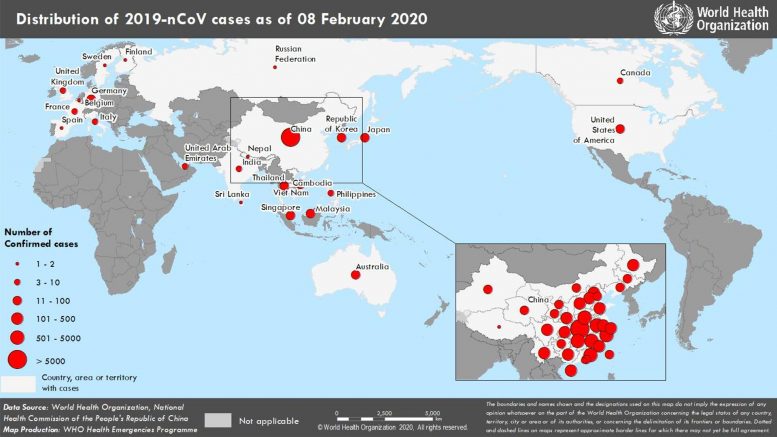
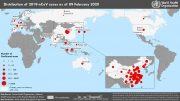
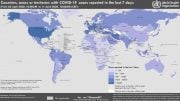
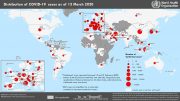
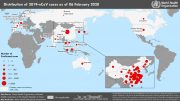
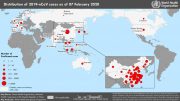
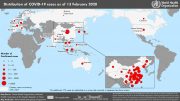
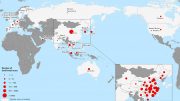
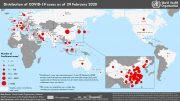
Be the first to comment on "Coronavirus Outbreak Climbs to 34,886 Confirmed Cases Worldwide and 724 Dead"